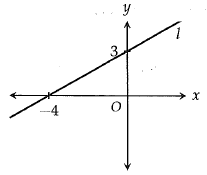LINES AND SLOPES PRACTICE PROBLEMS IN SAT
Subscribe to our ▶️ YouTube channel 🔴 for the latest videos, updates, and tips.
Problem 1 :
In the xy plane, the lines
y = mx - 7 are 2x + 3y = 6
are parallel. What is the value of m ?
Solution :
Slope of the line y = mx - 7 :
By comparing the given equation with slope intercept form
y = mx + b
m1 = m
Slope of the line 2x + 3y = 6 :
3y = -2x + 6
Dividing by 3 on both sides.
y = (-2/3) x + (6/3)
y = (-2/3) x + 2
m2 = -2/3
Since the given lines are parallel,
m1 = m2
m = -2/3
Problem 2 :

The graph of the line l is shown in the xy plane above. The equation of line n (not shown) is y = mx + b, where m and b are constants. If line l is perpendicular to the line n, which of the following must be true ?
(a) m < 0 (b) m > 0 (c) b < 0 (d) b > 0
Solution :
The given graph shows line (l) is a falling line and it will have negative slope.
If we draw the line which is perpendicular to the given line, it must be a raising line.
Raising line will have positive slope. So, m > 0
Problem 3 :

In the xy plane above, line l has slope -5/4. What is the area of the triangle bounded by the line l, the x-axis and the y-axis ?
(a) 5 (b) 8 (c) 10 (d) 16
Solution :
Since it is a falling line, it will have negative slope.
Rise = 5 and run = 4
Area of the triangle = (1/2) x base x height
Base = 4 and height = 5
= (1/2) x 5 x 4
= 10
Problem 4 :
In the xy plane, the line with the equation 3x + 4y = 6 is perpendicular to the line with the equation y = mx + b, where m and b are constants. What is the value of m ?
(a) 4/3 (b) -4/3 (c) 3/4 (d) -3/4
Solution :
Slope of the line 3x + 4y = 6 :
4y = -3x + 6
y = (-3/4) x + (6/4)
y = (-3/4) x + (3/2)
Slope of the line = -3/4
Slope of the perpendicular line = -1/(-3/4)
= - 4/3
Problem 5 :
If m and b are real numbers and m > 0 and b > 0 then the line whose equation is y = mx + b cannot contain which of the following points ?
(a) (0, 1) (b) (1, 1) (C) (-1, 1) (d) (0, -1)
Solution :
Since m > 0, it should be a raising line and it has positive y-intercept.
Then, it should be in the first and second quadrants, in the given set of options (d) contains the point from fourth quadrant.
So, (0, -1) is not one of the points on the line.
Problem 6 :
In which of the following figures is the slope of the line shown closest to -1/2 ?

Solution :
By observing the options, B and D are falling line, they will have negative slopes.
In -1/2, Rise = 1 and run = 2 units. So, option D is correct.
Problem 7 :

The graph of the line l is shown in the xy plane above. The y-intercept of the line l is 3 and the x-intercept is -4. If the line m is perpendicular to line l, what is the slope of the line m ?
(a) -4/3 (b) -3/4 (C) -1/2 (d) 3/4
Solution :
Slope of the given line is raising line, so, it will have positive slope.
Rise = 3 and run = 4
Slope of the line = 3/4
Slope of the line which is perpendicular to the line = -4/3
Problem 8 :
In the xy-plane, line l passes through (0, 0) and is perpendicular to the line 3x + y = c, where c is a constant. If two lines intersect at the point (k, k - 4), what is the value of k ?
(a) 4 (b) 6 (C) 8 (d) 10
Solution :
The line l passes through the point (0, 0) and the point of intersection of lines l and 3x + y = c is (k, k - 4).
Slope of the contains the points (0, 0) and (k, k - 4) is
m1 = (k - 4 - 0)/(k - 0)
m1 = (k - 4)/k
Slope of the line 3x + y = c
y = -3x + c
m2 = -3
Since these lines are perpendicular to each other, the product of their slopes will be equal to -1.
m1 x m2 = -1
[(k - 4)/k] (-3) = -1
-3(k - 4) = -k
3k - 12 = k
3k - k = 12
2k = 12
k = 6
Subscribe to our ▶️ YouTube channel 🔴 for the latest videos, updates, and tips.
Recent Articles
-
Finding Range of Values Inequality Problems
May 21, 24 08:51 PM
Finding Range of Values Inequality Problems -
Solving Two Step Inequality Word Problems
May 21, 24 08:51 AM
Solving Two Step Inequality Word Problems -
Exponential Function Context and Data Modeling
May 20, 24 10:45 PM
Exponential Function Context and Data Modeling